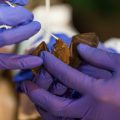The digital transformation of a virtual Smithsonian
We have lofty goals. But we also have an ambitious strategy to achieve them.

You have likely heard me say it before: my goal is for the Smithsonian to be a part of every home and every classroom in America; to become a vital, trusted, widely used source of knowledge and learning; and to help our audiences, wherever they are and whoever they are, grapple with the challenges they face.
These are lofty aspirations, but I am convinced we can meet them by becoming a truly virtual Smithsonian. We can and must develop a holistic, thorough digital strategy for how to get there. Doing so will enable us to grow our reach and our impact in ways that might have seemed impossible pre-pandemic. Over the past two years, we have seen the difference we can make when we reach our audiences where they are in their everyday lives.
“If we were to start the Smithsonian today, what would it look like?” asked Becky Kobberod, our new head of digital transformation. “Of course, we would have our buildings, collections, and research anchoring us. But we also have so many new opportunities to fulfill our mission that weren’t available 175 years ago or even 5 years ago. New tools, new technologies, new data, new ways of reaching and connecting with individuals who are seeking out knowledge from a trusted source like the Smithsonian.”
Digital transformation is not meant to replace our physical spaces or our in-person experiences. If anything, COVID-19 has shown how much we all crave personal, firsthand interaction. But for too long at the Smithsonian, we have understood our digital offerings as accessories to our in-person offerings instead of robust, engaging experiences in their own right. For millions across the country and the world, our digital offerings are their primary form of engagement with the Smithsonian.
Discussions with Becky, the entire leadership team, and staff across the institution, have made apparent our need to evolve into a more technologically savvy institution. Although we are still in the early planning stages of what digital transformation will look like, there are a few meaningful steps we can take to get started.
What has always set the Smithsonian apart is our unique ability to strike the right balance between tradition and innovation.
First, we need to get a handle on what we already do. We have amazing work happening at the unit level, and we have already invested significant time and money in this sphere. I think of virtual exhibition experiences and online programming or Smithsonian-wide efforts like Learning Lab and Open Access. The big question ahead of us is how to synthesize these discrete efforts to build a cohesive, pan-institutional strategy. Once we understand where we are today, we can begin to craft a longer-term roadmap for the Smithsonian, taking advantage of opportunities to leverage our current capacities and identifying areas in which we can pilot more digital innovation going forward.
As a part of these efforts, it is essential to me that we begin to develop an audience-first approach, using data to guide our decision-making. What do we know about our audiences? How do they interact with us? What are they interested in? By taking a step back and listening, we have the potential for even greater impact by fulfilling real needs. During my career at the Smithsonian, I have often seen us follow a “build it and they will come” approach. If we can harness that same expertise, creativity, and richness, but tailor it more precisely for our audiences, we can provide an even greater impact. We have millions of assets and an incredible wealth of knowledge to share with our public. My goal is to provide the right experience through the right platform at the right time for the greater good.
Finally, digital transformation represents an investment in our people. Our vision for a virtual Smithsonian is only possible if we develop the necessary tools and skills to get us there. Executing this goal will require us to build technological capacities and digital literacy. I hope to identify operational and administrative practices in which we can become more efficient; processes that we can streamline to become a nimbler, more flexible institution; areas in which we can empower staff to use new resources to make their jobs easier. Equipping people with better tools, training, and time will help all of us—and the institution itself—become more successful.
What has always set the Smithsonian apart is our unique ability to strike the right balance between tradition and innovation. In the coming months, you will hear more details about our digital transformation efforts and how they reflect that balance. Looking forward to the new year and beyond, I have the highest faith in this institution. As we have done for the past 175 years, we will celebrate our heritage, embrace change, and continue to serve to our fullest capacity.
Posted: 19 January 2022
- Categories:







